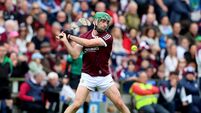Limerick rebirth will come from selection, not the axe

LIMERICK REBIRTH: The measure of John Kiely is such that he is now regarded in the same breath as the other two architects of era-defining teams.
The measure of John Kiely is such that he is now regarded in the same breath as the other two architects of era-defining teams. Ruthlessness was the calling card for Messrs Brian Cody and Jim Gavin. It is by that same yardstick that he will now be assessed.
Squad regeneration is too often presented as some sort of zero-sum adventure game. Trust in the stalwarts and endure the consequences. Or swing the axe, show zero remorse, prune the deadwood. And lo, reap the reward.
Gavin’s first reinvention started before they had lifted any silverware. In the off-season of 2012, word began to spread of several casualties. Paul Brogan, Ross McConnell, Michael Savage and Eamon Fennell were let go as the new boss met with the panel to outline his vision for the future.
There were reports that a big-name veteran was considering his future, with Stephen Cluxton’s name in the headlines. Just imagine the world in which that had been true. Over the course of the next seven years, Gavin replaced seamlessly, suppressing sentiment to keep the edge alive. It was an exercise in cold precision.
Cody’s cut-throat nature was a constant, out of or in season. Two weeks before the 2005 Leinster hurling final, he dropped seven players from the squad. There could be no room for comfort.
Last year’s All-Ireland-winning managers both demonstrated their own capacity for big calls. Tipperary’s campaign began with a host of big-name departures such as Cathal Barrett and Barry Heffernan. Almost 12 months ago, Dr Crokes forward Micheál Burns clarified that he was dropped from the 2024 Kerry panel and did not leave of his own accord. And yet, come 2025, he was back and played his part in their All-Ireland success, coming on as a sub as recently as the semi-final against Tyrone.
Kiely’s decision to omit several players who featured competitively this year is a pointed one. Séamus Flanagan, Micheál Houlihan, Fergal O'Connor and Jason Gillane all saw competitive action in 2025. It is noteworthy that they have now left, but it is not abnormal. This is part of the process. Teams evolve. Players come and go. Tough calls have to be made. The machine must roll on.
Sport has an infuriating ability to evade the neat logic we try to impart on it. Was Cahill’s cull a defining moment in the success they went on to enjoy? Perhaps. Equally, his trust in specific veterans was crucial. Two of his most reliable impact substitutes were well into their 30s, Séamus Kennedy and Noel McGrath. John McGrath returned for their opening championship game having not started in championship since 2022. With his first six possessions, he was turned over three times and hit a wide. He finished with 2-1 and is a serious contender to be Player of the Year. That is the benefit of faith.
Other managers made significant culls too, with little payoff. Micheál Donoghue’s return to Galway included three omissions. There was little resulting spark.
The thread that unites all of these is that it’s about who you trust, not who you drop. Team selection is the ultimate test of conviction. Did Donoghue inject sufficient freshness with his starting 15? Gavin, Cahill, Cody and O’Connor recognised that certain players were better from the bench rather than starting. Even when they made statement omissions, like not starting Bernard Brogan or Henry Shefflin, they saw their use and found a role in the 26.
For Limerick, at least 10 of the starting team from the 2018 breakthrough would have been considered a guaranteed starter seven years later. Several significant changes, like Declan Hannon, Darragh O’Donovan or Flanagan originally, were brought about because of injury rather than form.
Paul Kinnerk and Kiely’s brand of reinvention has so far been defined more by positional ingenuity. The redeployment of Barry Nash or Kyle Hayes were inspired ventures. More recently, he focused on ensuring their collective mind was sufficiently conditioned.
Throughout the course of the championship, the Limerick boss gave an exhibition in reinforcing the message that they were still in their prime. Over and over again, he referenced their sublime physical condition.
“Really happy with where we are at,” he said after the Waterford victory in the Munster championship. “The numbers they are producing are just through the roof.” He explicitly pushed back against the criticism of their miles on the clock, arguing that some people are simply tired of them winning.
“There are many, many years left in the legs of these guys, I can assure you. They’re not metal, they’re not going to corrode or degrade.”
While he will inevitably be compared to the Cody or Gavin way, Kiely is his own leader. It is only right that he does it his own way and in his own style. Yet it was last March, in a dead-rubber league fixture, in front of a modest crowd and with no television cameras present, that Kiely told the media they were facing one of their most formidable challenges. Two years on from their last Liam MacCarthy Cup, they now face a stiffer one still. He is striving to do what previous generational managers did.
The point is this: great teams are constantly in search of new edges. Every season, they need cause to believe the group can go again. A reason to go better. Is there clear evidence that the group are sharper, fitter, fresher?
If so, from that, all else will flow.










